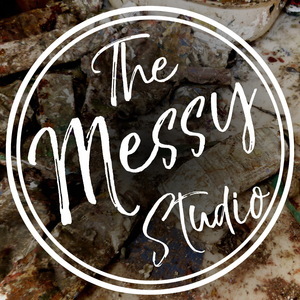Deep or Wide - What's Your Focus?
Episode 79 · July 7th, 2019 · 34 mins 24 secs
About this Episode
Intro
www.rebeccacrowell.com
www.squeegeepress.com
www.facebook.com/messystudiopodcast
NOTES:
This topic comes up a lot in workshops—"I’m too scattered”— work is all over the place
-wanting more focus, direction, way to bring depth to their work.
But also said in a positive way-- “I have a lot of interests.” “A lot of things excite me.”
In either case, we’re talking about someone who works in a lot of different media or styles
First—it can indeed be a positive thing.
--A necessary stage of searching at the beginning of your art journey
--if you’re blocked –try new things can be good advice
--basic attitude of being open and exploratory is good
--working in various media can cross-pollinate and be very helpful
some well-developed artists work across media and subject matter:
Usually conceptually drive—an underlying continuity of ideas, emotions, or which visual elements they are drawn to. Sense of connection, Open to any form that expresses what they want to say. Interests are dealt with in a focused way.
Example: Picasso, Gerhart Richter, lots of contemporary artists who work in installation format with many components tied together conceptually
Negative aspects:
From less developed artists:
Scattered, lack of focus or consistent voice, work lacks depth, can seem derivative
Use “Is it me?” to decide what you are really connected with, that you have focused on in a sustained way. Recognize that consistency is an aspect of personal voice.
The objective judgement is whether the work is high quality, well-developed, mastery of media—this comes only through sustained focus
May not be obvious as a rut type of comfort zone (stagnation)
gives feeling of change, exploration. Can be defended as this, a deflection attitude for any criticism that the work lacks depth.
Comfortable because easier to skim surface than dig deeply.
Being in “forever a student” mode is a comfort zone that may impeded your progress
If you are in this kind of rut recognize that it involves a lot of avoidance behavior:
Avoiding frustration
Avoiding criticism
Avoiding need to explain or understand the work
Avoiding taking next steps in your career and putting yourself out there
Avoiding success and the challenges that come with that
Lack of commitment means you never have to really excel or challenge yourself
Like being unable to commit to a relationship and weather the hard parts
Can be hard to recognize in yourself—easy to justify—you have a lot of interests, so many things to try—you’re generally excited about your work and it feels good. You may not see it as a problem.
And it is not a problem if you are truly happy with things as they are. It’s your work and entirely up to you if you want to change. Is it a choice or default mode?
If you don’t feel happy with it --how to identify this a negative kind of comfort zone?
questions:
Do you have basic underlying intentions that you bring to all your work
Does personal voice show itself in an overall, connected way
Are their particular visual elements you explore consistently?
Is your work recognizable as yours?
Do you find it hard to talk about your work beyond that you like to experiment and play?
Have you ever spent time developing the various things that interest you; focused attention?
In an exhibit showing of various examples of your approaches, would viewers see a conversation between your various pieces-- or would it seem disjointed?
How to move away from this—
Central concept is INTENTIONS
Identifying what you want in your work provides consistency and focus
Re: avoiding skimming the surface, take a hard look at past work-- what felt most like you, what offers most potential
What do you think you can commit to exploring in depth?
Set a goal to work in only one medium or approach for a period of time (several months + depending on how much studio time you have) or in terms of # of pieces.
You may be easily distracted by your other projects—put them away, pack away other materials
Make yourself accountable to someone—arrange to show them what you’ve done or have n progress
Wrap-up:
Experimenting and exploring new ideas definitely has an important role in an art practice. We’ve covered ideas about change in previous podcasts. But it is also a pitfall to change so often that there is little depth or consistency in your work. If you recognize that as an issue for yourself, we hope this discussion has been helpful in moving past that particular rut.
